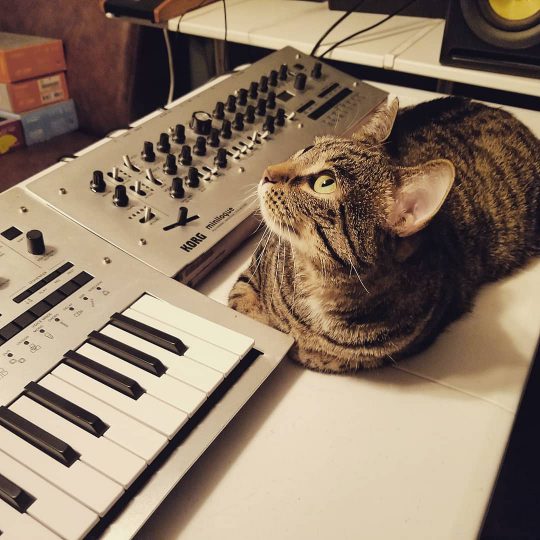
Cute tabby cat with two Korg Minilogue synthesizers. It looks like one of them is the special “sawed off” model 😹
Photo from flohrdumal on Instagram. This human and feline pair hail from Decatur, Georgia.


Cute tabby cat with two Korg Minilogue synthesizers. It looks like one of them is the special “sawed off” model 😹
Photo from flohrdumal on Instagram. This human and feline pair hail from Decatur, Georgia.
The Outsound New Music Summit continued on Wednesday with a night featuring explorations of electroacoustics and noise. Once again, the two acts were quite contrasting in their interpretations of the night’s theme.
SO AR (formerly Ze Bib) is the collaboration of electronic musician and cellist Shanna Sordahl and percussionist Robert Lopez. We had the chance to meet with them ahead of the summit and shared our encounter in this video:
The set unfolded as a series of conversations between Sordahl – first on cello alone and then with electronics – and Lopez. The ups and downs in the pitches, rhythms, and intensities seemed to imply spoken language at times. This was especially true during the more staccato and percussive sections at the beginning and end of the set.
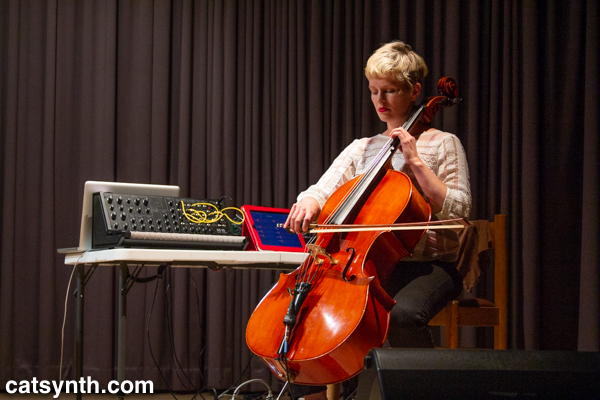
[Shanna Sordahl]
The long tone sections brought in more of the electronics – Sordahl’s rig featured a Korg MS-20 and iPad. The percussion once again seemed to match the longer tones, with extended rolls, long drum tones, and additional percussion. But there were also moments where the texture diverged, between long electronic tones and rhythmic percussion runs.
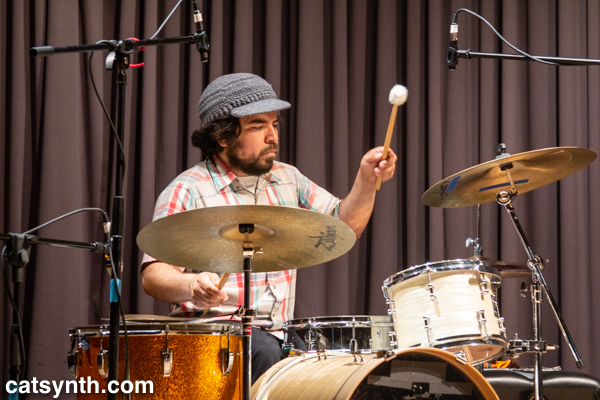
[Robert Lopez]
Even at its most intense, there was a quiet quality to the music that seemed fit with the starkness of their stage presence and the darkened hall. Even at low volume, the moments of silence stood out, with a bit of tension in the air. Space and breath are an important part of how the duo approaches their music, and this comes out strongest in the quietest sections.
X A M B U C A is a solo electronic project by Chandra Shukla. We had the opportunity to first see him perform last year with Hans-Joachim Roedellius at The Chapel in San Francisco; we were glad to see him join the lineup for this year’s Summit.
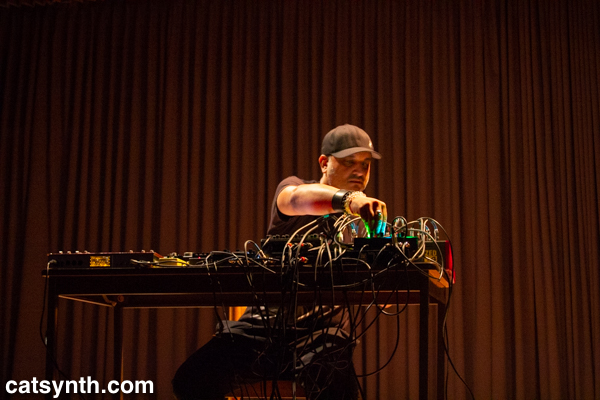
[X A M B U C A]
On a completely darkened stage, X A M B U C A delivered a set that was simultaneously rich and minimalist. There were segments of long drones cut with high-pitched sweeps, and sections of fast drum-machine runs. The styles of various sections (which segued from one to the next continuously) included fragmented dance-music patterns, elements of rock, and noise. It is, of course, hard for me not to consider electronic music without also considering the instruments used.
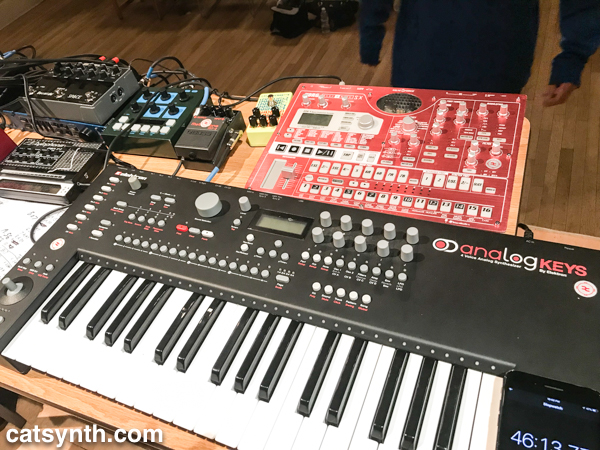
Shukla’s rig was anchored by an Elektron Analog Keys, along with a Korg Electribe, a Stylophone, and sundry pedals. Looking at these instruments, I can better understand how he was able to move so freely from drum patterns and hits to long tones and dense pads to distortion and noise. It was quite a dynamic performance, showing the more “experimental side” of X A M B U C A compared to what we had experienced previously.
It was a solid night, and perhaps the most “out” of the Outsound Summit shows this year, as subsequent nights embraced more idiomatic forms of musical expression. We hope to bring you those reviews over the next few days.
Little cat sitting on the corner of a Korg Poly-800 synthesizer. Submitted by thedigitalpurrgatory (Anton Largoza-Maza) via Instagram.
A cat on a synthesizer with time-and-space effects pedals. [Korg Poly-800, Malekko Ekko 616, GFI System Specular Tempus, Eventide TimeFactor]
Charlotte returns and shows off her Arturia MiniBrute, Roland SH-101 and Korg MS-2000 synthesizers. Submitted by Lee Tizzard via our Facebook page.
Today’s pic comes from Ok Housecat on Facebook.
This effect makes your music smell like cat litter
🆗
🏠
🐈
Please visit their page for more custom-electronics fun 😺
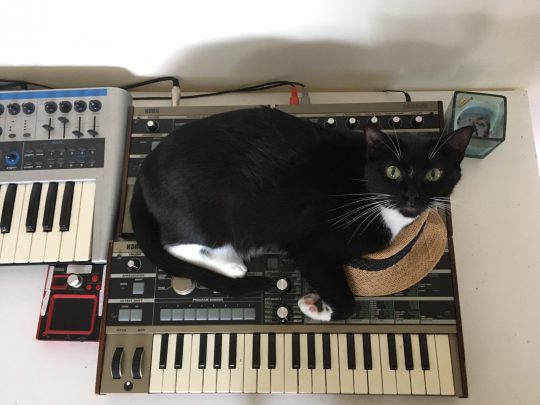
Dave (we’re pretty sure it’s Dave), sitting on top of a microKORG synthesizer. Actually, two microKORGs! That expression is priceless 😸
From Karl Lee Avery via Facebook.
We also espy a familiar red Korg Mini Kaoss Pad. We have one of those around here somewhere.
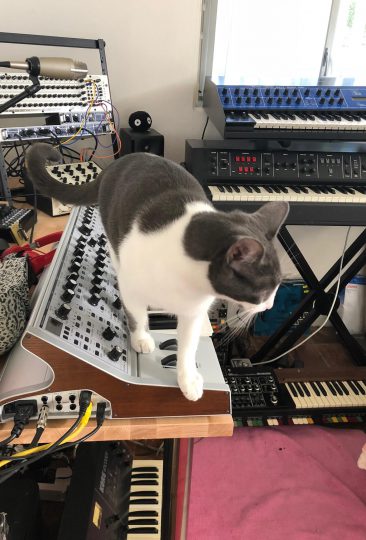
Gracie returns! This time we see her testing out one of her Moog synthesizers (a Sub37 or Subsequent 37). We also see a Korg vocoder below, and an Oberheim in the back. In the background, we see a PPG Wave, a rare DK Synergy below it, and a few other synths that we leave as exercises to the reader. Gracie always has such an impressive collection 😸
From Alsún Ní Chasaide via Facebook.
Those who follow our Instagram are regularly treated to photos and videos of Sam Sam and her adventures around CatSynth HQ. For those who don’t, we can assure you that she is doing well and is being spoiled rotten.

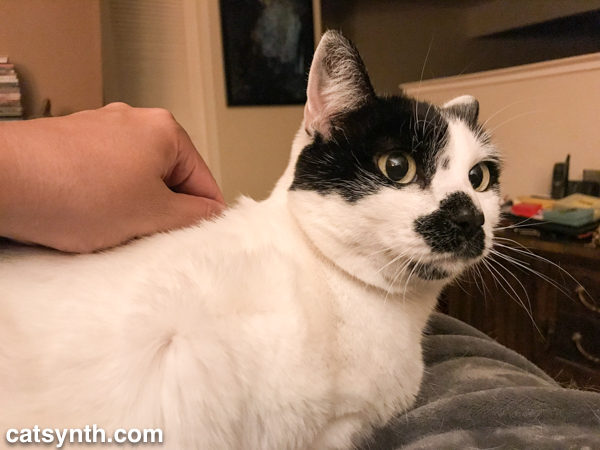
Sam Sam has made this blanket one of her favorite spots for napping and relaxing. It is quite warm and soft. In this video, we see her kneading it and purring up a storm.
It’s good to be the cat!
Here we see her posing with our Korg Volca FM sytnhesizer.
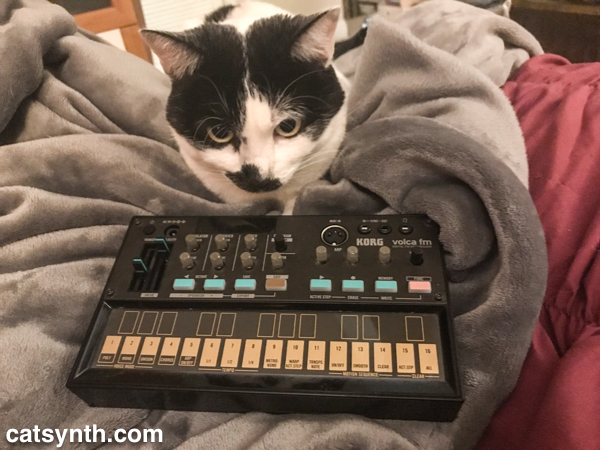
This photo was taken while preparing for our recent video on the Volca FM, which you can check out on YouTube. One of the nice things about these small battery-powered synths like the Korg Volcas and the Roland Boutiques is that we play them on the bed. And if I’m there playing a synth, reading, or napping, Sam Sam is likely to follow.
We hope you have a fun weekend, however you define it. And if you are Instagram, please do follow us 😻.
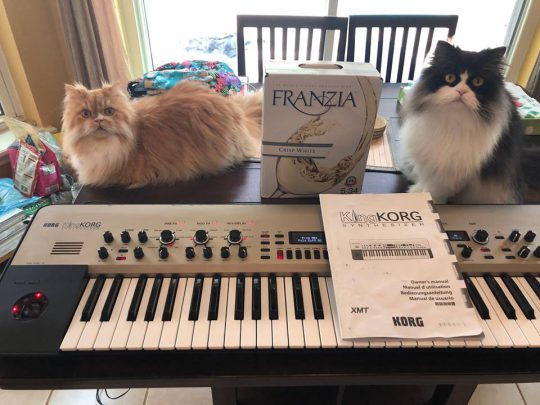
Two fluffy cats posing with a Korg KorgKorg synthesizer and a box of white wine (crisp and refreshing).
By Sayer Seely in the Facebook group Synthesizer Freaks
Just arrived… and cat approved… KingKorg!
Came up for sale locally at a great price. Just got the Novation Peak on Friday and now this. The wine in the box matches the color of the KingKorg!
I can’t resist including a link to one of my performances of my composition White Wine 😸